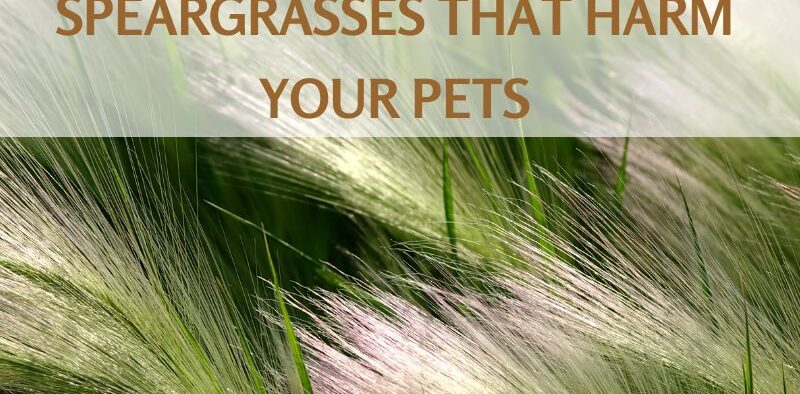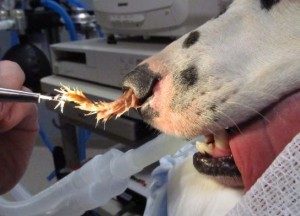Foxtails: The Speargrasses That Harm Your Pets
Share

Foxtails, those seemingly harmless wispy tails of wild grasses, transform into a summertime nightmare for many pets, especially dogs. As the days get hotter and drier, these grasses mature, hardening and developing tiny barbs that can wreak havoc on your pet’s health. These dangerous foxtails are predominately found in the West (yes, Arizona, they are all over our state)!
The danger lies in their one-way ticket into your pet’s body. These grasses are not like our amazing cat grasses. Rather, these barbed seeds can easily snag on fur or find their way into your dog’s paw pads, which allows them to burrow into your pet’s skin. Their insidious nature allows them to migrate deeper, causing serious issues like abscesses, swelling, pain and infections.
Our dog, Cheiss, was notorious for having to visit his veterinarian after walks in our desert. His hairy paws attracted foxtails like magic, despite our attempts to keep his fur trimmed short. We spent way too much having foxtails removed from our beloved dog!

Not only can theses grasses burrow into skin, they can also enter through your pet’s ear canals, providing a clear passage into your pet’s respiratory system. But, the absolute worst case is when they are accidentally inhaled, causing sneezing attacks as the barbs work further into your pet’s nostrils and eventually into the lower airways of their lungs. This can lead to discharge, swelling, pain and sadly, even death…
The Sneaky Culprits: Types of Foxtail Grasses
There are over 100 species of foxtail grass worldwide, but three main culprits pose the biggest threat to pets in North America:
- Yellow Foxtail (Setaria pumila or Setaria glauca): This is the most common type, with a slender stem and a cylindrical, bristly seed head that turns yellow-brown as it matures. It thrives in disturbed areas, wastelands, and along roadsides.
- Green Foxtail (Setaria viridis): Similar to yellow foxtail, but with a greener seed head that remains green even when dry. It prefers moist soils and is often found in lawns, pastures, and meadows.
- Giant Foxtail (Setaria faberi): The largest of the three, with a robust stem and a dense, bristly seed head that can reach several inches long. It’s a major invasive species and can be found in fields, wastelands, and disturbed habitats.
Spotting the Threat: How to Identify Foxtails
Knowing what to look for is crucial in protecting your pet. Here’s how to identify foxtails:
Seed Head
The telltale sign is the bristly, cylindrical seed head. In yellow foxtail, it starts green and turns yellow-brown, while green foxtail remains green. Giant foxtail has the largest, densest seed head.
Barbs
Look closely for tiny barbs on the individual seeds (spikelets) within the seed head. These barbs are what allow the foxtail to burrow and migrate.
Growth Pattern
Foxtails are annual grasses, meaning they complete their life cycle in one year. They sprout in spring or early summer, mature in mid-summer, and produce seeds in late summer/early fall.
Be a Foxtail Detective: Check your yard regularly, especially during the growing season. Pay close attention to areas with tall grasses, disturbed soil, or edges bordering wild areas. If you suspect foxtails, it’s better to be safe than sorry.
Warning Signs: How to Tell if Your Pets Have a Foxtail Intruder
Unfortunately, once your pets have traversed a field of foxtails, the issues can be virtually impossible to find. But, as Woodland Veterinary Hospital effectively illustrates in this article that details how foxtails are removed, it pays to be vigilant:

Here’s how to be a detective and identify potential foxtail problems in your dog:
- Eyes: Is your dog blinking excessively, squinting, or showing signs of redness and discharge around the eye? These could be signs that a foxtail has lodged itself in the delicate eye area. Pawing at the eye is another red flag.
- Nose: Keep an eye (and nose!) out for unusual nasal discharge or frequent, intense sneezing. These symptoms might indicate a foxtail has gotten lodged in the nasal passage, causing irritation.
- Genitals: Persistent licking of the genital area can be a sign of discomfort caused by a lodged foxtail. Be mindful of this behavior and check the area thoroughly.
- Fur: Check your pet’s fur by running your hand close to the skin and against the fur. When you pet them with the fur, the foxtails can disguise themselves as soft little pieces of hair.
Early Detection is Key!
If you notice any of these signs, don’t hesitate to take your dog to the vet immediately. Removing a foxtail can be a delicate process, and sometimes sedation or anesthesia is necessary. Early detection and intervention are crucial to prevent serious complications.
Removing the Threat: Getting Rid of Foxtails
Once you’ve identified foxtails, it’s important to remove them promptly. Here are some methods:
Hand-Pulling
This is the safest option for small infestations. Wear gloves and long sleeves for protection. Carefully pull the entire plant, including the root system, to prevent regrowth.
Herbicides
For larger infestations, consider using a selective herbicide labeled for foxtail control. Follow the instructions carefully, paying attention to application rates and safety precautions. Be mindful of nearby plants and your pet’s safety.
Landscaping Fabric
Consider laying down landscaping fabric in areas prone to foxtails. This will suppress weed growth, including foxtails. However, ensure proper drainage to prevent waterlogging.
Remember: Always prioritize your safety and your pet’s safety when dealing with foxtails. If you’re unsure about identification or removal methods, consult a professional landscaper or pest control service.
Beyond Your Yard: Keeping Your Pet Safe on Walks
Even with a foxtail-free yard, dangers lurk outside. Here are some precautions for walks and outdoor adventures:
- Avoid High-Risk Areas: Steer clear of overgrown fields, wild areas, and roadsides where foxtails are more prevalent.
- Stick to Paths: Keep your pet on designated walking paths or trails with well-maintained grass.
- Post-Walk Check: After every walk, thoroughly inspect your pet for any foxtails snagged on their fur, especially between the toes, around the ears, and under the tail. Use a flea comb for extra thoroughness.
By following these tips and being vigilant, you can significantly reduce the risk of foxtails harming your beloved pet. Remember, a little prevention goes a long way in keeping your furry friend safe and healthy throughout the year.


